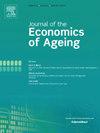老龄化和美国老年人的时间分配
IF 2
3区 经济学
Q2 DEMOGRAPHY
引用次数: 0
摘要
利用美国健康和退休研究的消费和活动邮件调查的纵向时间使用数据,论文研究了随着个人年龄的增长和退休过渡,时间分配的变化。考虑到个人观察到的和未观察到的异质性,我发现个人护理和休闲时间随着年龄的增长而急剧增加,而家庭生产时间除了在退休年龄前后略有增加外,没有显着变化。从工作到退休的过渡与花在所有非工作活动上的时间更多有关。然而,当人们退休时,非市场时间在各种活动中的相对分配并没有实质性的变化,从而表明习惯和行为的连续性。很大一部分用于有偿工作的时间被重新分配给了看电视,而退休后的体育休闲并没有增加。本文章由计算机程序翻译,如有差异,请以英文原文为准。
Ageing and the allocation of time among older Americans
Using longitudinal time use data from the Consumption and Activities Mail Survey of the U.S. Health and Retirement Study, the paper examines changes in time allocation as individuals grow older and transition to retirement. Accounting for individual observed and unobserved heterogeneity, I find that time spent on personal care and leisure sharply increases with age, while time spent on home production does not significantly vary with age, except for a small increase around retirement ages. Transition from working to retirement is associated with more time spent on all non-work activities. However, the relative allocation of non-market time across various activities does not substantially vary when people retire, thereby suggesting continuity in habits and behaviors. A large share of the time used for paid work is re-allocated to watching TV, while physical leisure does not increase after retirement.
求助全文
通过发布文献求助,成功后即可免费获取论文全文。
去求助
来源期刊

Journal of the Economics of Ageing
Multiple-
CiteScore
4.10
自引率
4.50%
发文量
46
审稿时长
49 days
期刊介绍:
The Journal of the Economics of Ageing (JEoA) is an international academic journal that publishes original theoretical and empirical research dealing with the interaction between demographic change and the economy. JEoA encompasses both microeconomic and macroeconomic perspectives and offers a platform for the discussion of topics including labour, health, and family economics, social security, income distribution, social mobility, immigration, productivity, structural change, economic growth and development. JEoA also solicits papers that have a policy focus.
 求助内容:
求助内容: 应助结果提醒方式:
应助结果提醒方式:


